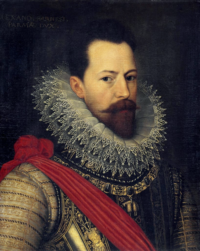|
Frederick Henry's Meuse campaign
The Meuse campaign was a major operation during the Dutch Revolt led by Frederick Henry, Prince of Orange in which he took the cities of Venlo, Roermond, Sittard and Maastricht.[1][2][3] BackgroundIn 1572, 6 years after the revolt broke out, the Geuzen who backed the Prince of Orange, captured a lot of cities in the Netherlands. Including the cities which were key locations for this campaign. The aftermath of this being that the Union of Utrecht was proclaimed in 1579.  Shortly after, Philip II sent the Duke of Parma to the Netherlands as governor and reconquered large parts of the Netherlands previously occupied and captured by the Rebels, including the cities that were captured during the Meuse campaign, the most notable one being Parma's siege of Maastricht.[1] Later in 1588, Maurice, Frederick's half-brother. Became the Prince of Orange and after his military reforms, conquered large parts of the territories previously captured by Parma, except for the cities that would be captured during this campaign.  In 1629, a few years before the initial campaign, Frederick Henry besieged and captured 's-Hertogenbosch, this would be known as his greatest achievement. The city of 's-Hertogenbosch was the last city that was in Spanish hands before Frederick could initiate his campaign. So the capture of 's-Hertogenbosch allowed Frederick Henry to launch his campaign. CampaignSiege of VenloThe Siege of Venlo was the first major action of the campaign. This siege lasted from 1 June until 4 June when the garrison in Venlo was forced to capitulate.[4][5] Siege of Roermond The Siege of Roermond occurred on 2 June until 5 June when a Dutch force of 20,000 men took on a Spanish garrison of around 300 men and forced the garrison to capitulate. Even though the Dutch Army successfully took the city of Roermond, the Dutch still suffered a heavy loss due to the death of Ernest Casimir when he got shot when inspecting a nearby trench. Ernest arrived at Roermond on the 2nd of June, a few hours later he was inspecting their respective trenches when he got hit with a bullet, killing him. After Venlo was captured, Frederick Henry heard about his death and arrived at Roermond with his entire army on the 4th of June. During the same morning, the officials of Roermond met at the town hall to discuss a surrender of the city. The same afternoon, a letter was presented which included the surrender of the city. The day after, the city capitulated under a few conditions, the most important ones being:
After Frederick entered the city on the 6th of June, the mayor Bossman presented him the keys of the city on the local market[6] Siege of Maastricht The siege of Maastricht was the last and most major military action during the campaign. The siege itself lasted from 9 June until 22 August, the siege was fought between the Dutch States Army led by Frederick and Horace Vere and the combined forces of the Spanish and Imperial armies. After the outnumbered Dutch forces successfully besieged the city, the city was left in Dutch hands.[7] AftermathEven though the campaign was a success for the Dutch, the cities of Venlo and Roermond would be recaptured by Spanish forces under Cardinal-Infante Ferdinand during his counter-offensive in the summer of 1637. The Cardinal-Infante would also fully cut off Maastricht through doing so and prevent any further Dutch attacks from the Meuse in the future. The city of Maastricht would be besieged again in 1634 by Spanish forces, but without success. The campaign resulted in Maastricht falling entirely into Dutch hands. Maastricht would become one of the most important Dutch fortresses and was besieged in 1673, 1676, 1748, 1793 and 1794. Notes
References
Sources
|
||||||||||||||||||||||||||
